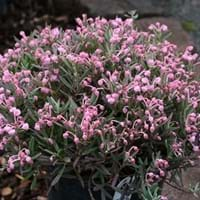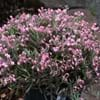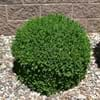Life Span
Annual and Perennial
Perennial
Type
Broadleaf Evergreen
Flowering Plants, Shrubs
Origin
North America, Europe, Asia
Eastern Asia
Types
Andromeda polifolia var. polifolia, Andromeda polifolia var. glaucophylla
Not Available
Number of Varieties
Not Available
Habitat
Bog Garden, Fens, Swamps
Barren waste areas, disturbed sites, Fields, Forests, Wet lands
USDA Hardiness Zone
2-6
4-11
AHS Heat Zone
Not Available
Not Available
Sunset Zone
Not Available
Not Available
Habit
Cushion/Mound-forming
Cushion/Mound-forming
Flower Color
White, Pink, Light Pink
White, Yellow
Flower Color Modifier
Not Available
Bicolor
Fruit Color
Not Available
Black
Leaf Color in Spring
Gray Green
Green
Leaf Color in Summer
Gray Green
Green
Leaf Color in Fall
Gray Green
Green
Leaf Color in Winter
Gray Green
Green
Leaf Shape
Long Linear
Oval
Plant Season
Spring, Summer, Fall, Winter
Summer
Sunlight
Full Sun, Partial Sun, Partial shade
Full Sun, Partial shade
Type of Soil
Loam
Well drained
The pH of Soil
Acidic
Neutral
Soil Drainage
Average
Well drained
Bloom Time
Late Spring, Early Summer
Late Winter, Spring, Summer
Tolerances
Not Available
Drought
Where to Plant?
Container, Ground
Ground
How to Plant?
Seedlings
Layering, Seedlings, Stem Cutting
Plant Maintenance
Medium
Medium
Watering Requirements
Do not let dry out between waterings, Keep ground moist
Get enough water whenever the soil is dry
In Summer
Average Water, Ample Water
Lots of watering
In Spring
Ample Water
Moderate
In Winter
Not so frequently
Average Water
Soil Type
Loam
Well drained
Soil Drainage Capacity
Average
Well drained
Sun Exposure
Full Sun, Partial Sun, Partial shade
Full Sun
Pruning
Prune for size control, Remove short twigs
Remove dead or diseased plant parts
Fertilizers
fertilize in spring
All-Purpose Liquid Fertilizer, General garden fertilizer
Pests and Diseases
No serious insect or disease problems
Not Available
Plant Tolerance
Not Available
Drought
Flower Petal Number
Single
Single
Foliage Texture
Fine
Not Available
Foliage Sheen
Matte
Not Available
Attracts
pollinators
Bees, Birds, Butterflies
Allergy
Not Available
poisonous if ingested, Skin irritation
Aesthetic Uses
Showy Purposes
Showy Purposes
Beauty Benefits
Not Available
Not Available
Environmental Uses
Not Available
Air purification, Food for birds
Medicinal Uses
Not Available
Fever, Sore throat, Stomach aliments
Part of Plant Used
Flowers
Flowers, Leaves
Other Uses
As a tea substitute
Making Perfumes, Used as Ornamental plant, Used for its medicinal properties
Used As Indoor Plant
No
No
Used As Outdoor Plant
Yes
Yes
Garden Design
Bog Garden, Container, Mixed Border, Rock Garden, Wall
Container, Cutflower, Dried Flower/Everlasting, Groundcover, Mixed Border, Rock Garden / Wall
Botanical Name
ANDROMEDA polifolia
Lonicera japonica
Common Name
Bog Rosemary
Japanese Honeysuckle, suikazura, jinyinhua
In Hindi
Bog Rosemary
जापानी Honeysuckle
In German
Rosmarinheide
Japanese Honeysuckle
In French
Andromeda polifolia
Chèvrefeuille japonais
In Spanish
Andromeda polifolia
madreselva japonesa
In Greek
Bog Rosemary
Το ιαπωνικό αγιόκλημα
In Portuguese
Bog Rosemary
Honeysuckle japonês
In Polish
Modrzewnica zwyczajna
wiciokrzew japoński
In Latin
Bog Rosemary
CISSANTHEMOS Italica
Phylum
Magnoliophyta
Magnoliophyta
Class
Magnoliopsida
Magnoliopsida
Order
Ericales
Dipsacales
Family
Ericaceae
Caprifoliaceae
Clade
Angiosperms, Asterids, Eudicots
Angiosperms, Asterids, Eudicots
Tribe
Not Available
Not Available
Subfamily
Vaccinioideae
Not Available
Difference Between Bog Rosemary and Japanese Honeysuckle
If you are confused whether Bog Rosemary or Japanese Honeysuckle are same, here are some features about those plants to help you choose better. Many people think that these two plants have the same characteristics, but one can see Bog Rosemary and Japanese Honeysuckle Information and learn more about it. Fertilizers required for proper growth of Bog Rosemary are fertilize in spring, whereas for Japanese Honeysuckle fertilizers required are All-Purpose Liquid Fertilizer and General garden fertilizer. Hence, one should know the basic difference between Bog Rosemary and Japanese Honeysuckle if you are planning to have them in your garden to enhance its beauty.
<
Flowering PlantsImportance of Bog Rosemary and Japanese Honeysuckle
Want to have the most appropriate plant for your garden? You might want to know the importance of Bog Rosemary and Japanese Honeysuckle. Basically, these two plants vary in many aspects. Compare Bog Rosemary and Japanese Honeysuckle as they differ in many characteristics such as their life, care, benefits, facts, etc. Every gardener must at least have the slightest clue about the plants he wants to plant in his garden. Compare their benefits, which differ in many ways like facts and uses. The medicinal use of Bog Rosemary is Not Available whereas of Japanese Honeysuckle is Fever, Sore throat and Stomach aliments. Bog Rosemary has beauty benefits as follows: Not Available while Japanese Honeysuckle has beauty benefits as follows: Not Available.
Compare Facts of Bog Rosemary vs Japanese Honeysuckle
How to choose the best garden plant for your garden depending upon its facts? Here garden plant comparison will help you to solve this query. Compare the facts of Bog Rosemary vs Japanese Honeysuckle and know which one to choose. As garden plants have benefits and other uses, allergy is also a major drawback of plants for some people. Allergic reactions of Bog Rosemary are Not Available whereas of Japanese Honeysuckle have poisonous if ingested and Skin irritation respectively. Having a fruit bearing plant in your garden can be a plus point of your garden. Bog Rosemary has no showy fruits and Japanese Honeysuckle has no showy fruits. Also Bog Rosemary is not flowering and Japanese Honeysuckle is flowering. You can compare Bog Rosemary and Japanese Honeysuckle facts and facts of other plants too.




